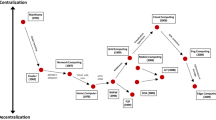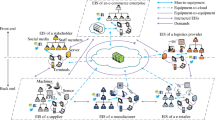Abstract
We described in earlier publications the principles of a system where Internet content would be pre-cached, based on contextual information obtained from a user’s electronic calendar. The model for such a system envisioned a set of cooperating agents, distributed on a user’s desktop and mobile device, which would be responsible for making decisions on the context and preferences of the user, and downloading the relevant internet content through a land-based broadband connection and storing it on the mobile device. This paper presents and discusses established pre-caching techniques and their suitability for use on mobile information access scenarios. It proceeds in describing the implementation details of an alternative approach, a calendar-based pre-caching system and presents the findings of tests that were made with human subjects on such a system.









Similar content being viewed by others
Notes
Garnethill, a region in the Glasgow city centre area (UK).
HAYES, R.M., 'Mathematical models in information retrieval', in Natural Language and the Computer (Edited by P.L. Garvin), McGraw-Hill, New York, 287 (1963).
Google Adwords keyword suggestion tool: https://www.adwords.google.com/select/main?cmd=KeywordSandbox
References
Balabanovic M, Shohav Y, Yun Y (1995) An adaptive agent for automated web browsing. J Vis Commun Image Represent 6:4
Wang Z, Crowcroft J (1996) Prefetching in the world wide web. In: Proceedings IEEE global internet conference, London
Cunha C, Jaccoud C (1997) International symposium on computers and communication 97, Alexandria
Thiebaut D (1989) On the fractal dimension of computer programs and its applications to the prediction of the cache miss ratio. IEEE Trans Comput 38(7):1012–1026
Palpanas T (1998) Web prefetching using partial match prediction. In: Proceedings of the 4th international web caching workshop, San Diego
Jiang Z, Kleinrock L (1998) An adaptive network prefetch scheme. IEEE J Sel Areas Commun 16(3):358–368, 1–11
Jiang Z, Kleinrock L (1998) Web prefetching in a mobile environment. IEEE Pers Commun 5:25–34
Chinen K, Yamaguchi S (1997) An interactive prefetching proxy server for Improvement of www latency. In: Proceedings of INET97, June 1997
Duchamp D (1999) Prefetching hyperlinks. In: Proceedings of the 2nd USENIX symposium on Internet technologies and systems, Boulder, Colorado
Fan L, Jacobson Q, Cao P, Lin W (1999) Web prefetching between low-bandwidth clients and proxies: potential and performance. In: Proceedings of the joint international conference on measurement and modelling of computer systems (SIGMETRICS 99). Atlanta, Georgia
Pitkow J, Pirolli P (1999) Mining longest repeated subsequences to predict www surfing. In: Proceedings of the second USENIX symposium on Internet technologies and systems, October 1999
Schechter S, Krishnan M, Smith MD (1998) Using path profiles to predict HTTP requests. In: Proceedings of the seventh international www conference. Brisbane, pp 457–467
Padmanabhan V, Mogul JC (1996) Using predictive prefetching to improve www latency. ACM SIGCOMM Comput Commun Rev 26(3):22–36
Crow D, Smith B, Habits DB (1992) Comparing minimal knowledge and knowledge-based approaches to pattern recognition in the domain of user-computer interactions, neural networks and pattern recognition in human computer interaction. Ellis Horwood, New York, pp 39–63
Swaminathan N, Raghavan SV (2000) Intelligent pre-fetching in www using client behaviour characterization. In: Proceedings of the eighth international symposium on modeling, analysis and simulation of computer and telecommunication systems (MASCOTS)
Foygel D, Strelow D (2000) Reducing web latency with hierarchical cache-based prefetching. In: Proceedings of the international workshop on scalable web services (in conjunction with ICPPO), Toronto
Davison B (2002) Predicting web actions from HTML content. In: Proceedings of the 13th ACM conference on hypertext and hypermedia, College Park, pp 159–168
Zhang W, Lewanda DB, Janneck CD, Davison BD (2003) Personalized web prefetching in Mozilla. Technical report LU-CSE-03–006, Department of Computer Science and Engineering, Lehigh University
Davison B (2004) Learning Web Request Patterns. In: Poulovassilis A, Levene M (eds) Web dynamics: adapting to change in content, size, topology and use. Springer, Heidelberg
Cohen E, Kaplan H (2000) Pre-fetching the means for document transfer: a new approach for reducing web latency. In: Proceedings of the 2000 IEEE INFOCOM conference. Tel-Aviv, pp 854–863
Komninos A, Dunlop MD (2003) Towards a model for an Internet content pre-caching agent for small computing devices. In: Proceedings of the 10th international conference on human computer interaction (HCII2003), Crete
Kincaid CM, Dupont PD, Kaye AR (1985) Electronic calendars in the office: an assessment of user needs and current technology. ACM Trans Off Inf Syst 3(1):89–102
Appelt D, Israel DJ (1999) Introduction to information extraction technology. Int J Commun Artif Intell 12:161–172
Komninos A, Dunlop MD (2004) Keyword based categorisation of calendar entries to support personal internet content pre-caching on mobile devices, 2nd international workshop on mobile and ubiquitous information access (MUIA04), in conjunction with Mobile HCI04. Glasgow
Jansen BJ, Spink A, Bateman J, Sarasevic T (1998) Real life information retrieval: a study of user queries on the web. ACM SIGIR Forum 32(1):5–17
Jansen B, Spink A (2003) An analysis of web documents retrieved and viewed. In: Proceedings of the 4th international conference on Internet computing. Las Vegas, pp 65–69
Nielsen J, Morkes J (1997) Conscise scannable and objective: how to write for the web, http://www.useit.com/papers/webwriting/writing.html. Link valid January 2005
Claypool M, Le P, Waseda M, Brown D (2001) Implicit interest indicators. In: Proceedings of the 6th international conference on intelligent user interfaces (IUI ‘01), USA, pp 33–40
Morita M, Shinoda Y (1994) Information filtering based on user behavior analysis and best match text retrieval. In: Proceedings of the 17th annual international ACM SIGIR conference on research and development in information retrieval. Ireland, pp 272–281
Kelly D, Belkin N (2001) Reading time, scrolling and interaction: exploring implicit sources of user preferences for relevance feedback. In: Proceedings of the 24th annual international ACM conference on research and development in information retrieval. New Orleans, pp 408–409
Kelly JD (2004) Understanding implicit feedback and document preference: a naturalistic user study. PhD Thesis, State University of New Jersey
Author information
Authors and Affiliations
Corresponding author
Rights and permissions
About this article
Cite this article
Komninos, A., Dunlop, M.D. A calendar based Internet content pre-caching agent for small computing devices. Pers Ubiquit Comput 12, 495–512 (2008). https://doi.org/10.1007/s00779-007-0153-4
Received:
Accepted:
Published:
Issue Date:
DOI: https://doi.org/10.1007/s00779-007-0153-4




